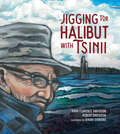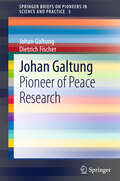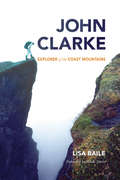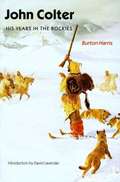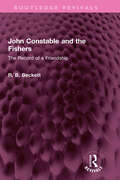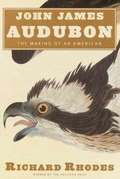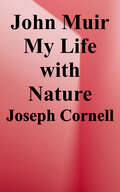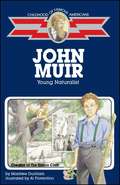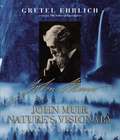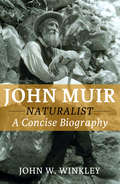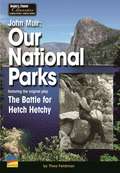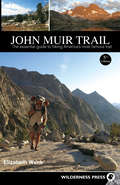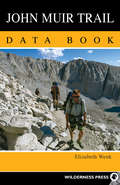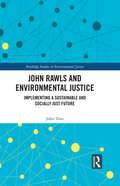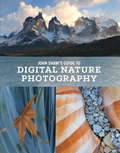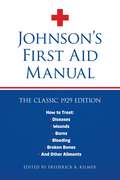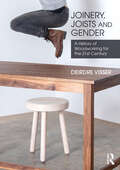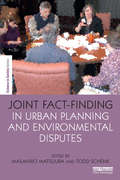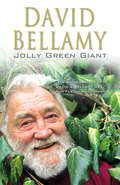- Table View
- List View
Jigging for Halibut With Tsinii (Sk'ad'a Stories Series #1)
by Robert Davidson Sara Florence DavidsonBased on Haida artist Robert Davidson's own experiences with Tsinii (his grandfather), this tender story highlights intergenerational knowledge and authentic learning experiences.Off the northern tip of Haida Gwaii, a boy goes fishing with Tsinii, his grandfather. As they watch the weather, jig for halibut, and row with the tides, the boy realizes there&’s more to learn from Tsinii than how to catch a fish.Written by the creators of Potlatch as Pedagogy, this book brings the Sk'ad'a Principles to life through the art of Janine Gibbons.
Jigging for Halibut With Tsinii (Sk'ad'a Stories Series #1)
by Sara Florence Davidson Robert DavidsonBased on Haida artist Robert Davidson's own experiences with Tsinii (his grandfather), this tender story highlights intergenerational knowledge and authentic learning experiences.Off the northern tip of Haida Gwaii, a boy goes fishing with Tsinii, his grandfather. As they watch the weather, jig for halibut, and row with the tides, the boy realizes there&’s more to learn from Tsinii than how to catch a fish.Written by the creators of Potlatch as Pedagogy, this book brings the Sk'ad'a Principles to life through the art of Janine Gibbons.
Johan Galtung
by Dietrich Fischer Johan GaltungThis is the first ever anthology of key articles by Johan Galtung, widely regarded as the founder of the academic discipline of peace studies. It covers such concepts as direct, structural and cultural violence; theories of conflict, development, civilization and peace; peaceful conflict transformation; peace education; mediation; reconciliation; a life-sustaining economy; macro-history; deep culture and deep structure; and social science methodology. Galtung has contributed original research, concepts and theories to more than 20 social science disciplines, including sociology, international relations and future studies, and has also applied his new insights in practice. The book is a valuable resource for researchers and practitioners, and can serve as a supplemental textbook for graduate and upper undergraduate courses in peace studies and related fields.
John Clarke
by Lisa BaileClarke had no interest in "trophy climbs" and never did ascend many of BC's highest peaks. On the other hand, he explored more virgin territory and racked up more first ascents than any other climber-perhaps more than any climber who ever lived.Although he came to be honoured far and wide and is one of the few mountaineers to be awarded the Order of Canada, he was a modest man who pursued his passion without fanfare, frequently embarking on gruelling expeditions into unknown territory by himself. His reputation spread and grew to legendary proportions, not just owing to the prodigious scale of his achievements, but because of the way he carried them out-he travelled light and scorned technology, wearing cotton long johns and eating homemade granola.He dedicated his life to exploring the numberless, nameless peaks of the Coast Range and worked at odd jobs just long enough to pay for the next season's climbing. He was charismatic and famously attractive to women, but none were able to compete with his first love and he didn't marry until he was almost fifty. Always a popular lecturer, in his later years he devoted his considerable energies to the cause of environmental education. After he succumbed to cancer in 2003, the BC government named Mount John Clarke in his honour-fitting recognition for the man who had himself named many BC mountains.John Clarke: Explorer of the Coast Mountains covers this remarkable life from beginning to end, examining Clarke through his own words and pictures as well as through the words of his many friends. All agree it was an honour to have known him, and readers will find it equally inspiring to meet him through these pages.
John Colter: His Years in the Rockies
by Burton Harris David G. LavenderJohn Colter was a crack hunter with the Lewis and Clark expedition before striking out on his own as a mountain man and fur trader. A solitary journey in the winter of 1807-8 took him into present-day Wyoming. To unbelieving trappers he later reported sights that inspired the name of Colter's Hell. It was a sulfurous place of hidden fires, smoking pits, and shooting water. And it was real. John Colter is known to history as probably the first white man to discover the region that now includes Yellowstone National Park. In a classic book, first published in 1952, Burton Harris weighs the facts and legends about a man who was dogged by misfortune and "robbed of the just rewards he had earned. " This Bison Book edition includes a 1977 addendum by the author and a new introduction by David Lavender, who considers Colter's remarkable winter journey in the light of current scholarship.
John Constable and the Fishers: The Record of a Friendship (Routledge Revivals)
by R B BeckettFirst published in 1952, John Constable and the Fishers is based on original letters which have never been published in full before. These have been woven into a connected narrative dealing with the friendship which existed between Constable and various members of the Fisher family, more particularly the Bishop of Salisbury (a personal friend of George III who entrusted him with the education of Princess Charlotte as heiress to the throne) and his nephew the Archdeacon of Berkshire. The Archdeacon’s letters give a picture of life in a cathedral closed and country vicarages, reminiscent of Trollope’s Barchester and Thomas Hardy’s Wessex. In return Constable confides his ideals and ambitions; and as Mr. Grigson suggests in his introduction, the encouragement he received from the Fishers may have had a decisive effect on the future of landscape art. The letters are fully annotated and are illustrated with connected works done by Constable. This book will of interest to students of history, art and literature.
John James Audubon: The Making of an American
by Richard RhodesAn award-winning author who has frequently explored science and American history offers the first major new biography in many years of ornithologist/artist John James Audubon (1785-1851). Rhodes traces Audubon's arrival in America from France, his (for a time) commuter marriage, and career culminating in his magnum opus The Birds of America. He presents a well-rounded portrait of the Audubon Society's namesake and the U. S. of the early frontier period. Illustrations include color plates of Audubon's celebrated watercolors of North American birds. Annotation ©2004 Book News, Inc. , Portland, OR (booknews. com)
John Muir
by Margaret Goff ClarkA biography of the nineteenth-century naturalist, explorer, and writer who was influential in establishing our national park system.
John Muir: My Life With Nature (A Sharing Nature With Children Book)
by Joseph CornellA biography of the man known as "father of America's national parks" and an influential conservationist, told in the first person, using Muir's own words.
John Muir: Young Naturalist (Childhood of Famous Americans Series)
by Montrew DunhamA founding father of the conservation movement in the United States, John Muir was born in Scotland and emigrated to Wisconsin when he was eleven. This easy-to-read fictionalized biography takes a look at Muir's life as young naturalist, destined to become one of America's first eco-heroes.
John Muir: Nature's Visionary
by Gretel EhrlichIn this definitive photobiography, Ehrlich brings her award-winning grace and insight to the life of one of our nation's most prized environmental heroes--John Muir, a founder of the Sierra Club.
John Muir
by Thomas LockerLaced with richly painted landscapes, this book brings readers the world and words of John Muir. This is the second book in a series of illustrated books by Thomas Locker that introduces readers to notable people who loved and wrote about the American land, especially about the value of wilderness.
John Muir: A Concise Biography of the Great Naturalist
by John W. WinkleyJohn Muir, Naturalist, first published in 1959, is an account of the life of John Muir (1838-1914) an early advocate of nature preservation. From his childhood in Scotland and the family’s move to Wisconsin, the book describes Muir’s early influences and his love of nature. After a time at the University of Wisconsin-Madison, and working in Indiana, Muir set off—on foot—to the Gulf of Mexico, and eventually ended in California, devoting time to the preservation of Yosemite and the western forests. In later life, Muir operated a large fruit farm in Martinez, California, while writing 12 books and over 300 articles, and co-founding the conservation organization the Sierra Club. Included are 6 pages of illustrations.
John Muir: Featuring the Original Play, The Battle for Hetch Hetchy (Readers Theater Classics)
by Thea FeldmanNIMAC-sourced textbook
John Muir Trail
by Elizabeth WenkLizzy Wenk's authoritative guide John Muir Trail describes the 212-mile trail, running from Yosemite Valley to the summit of Mt. Whitney. It provides all necessary planning information, including up-to-date details on wilderness and permit regulations, food resupplies, trailhead amenities, and travel from nearby cities. Useful essentials are updated GPS coordinates and maps for prominent campsites (along with an updated list of sites along the trail), trail junctions, bear boxes, and other points of interest. The trail descriptions also include natural and human history to provide a workout for both body and mind -- a must-have for any Muir Trail enthusiast. Note that the text includes the southbound trail description, while the full guide with the northbound description is available as a separate ebook product.
John Muir Trail Data Book
by Elizabeth WenkA derivative of the comprehensive John Muir Trail by Sierra expert Elizabeth Wenk, this data book is perfect for the weight-conscious hiker. A brief introductory section provides planning data, including information on permits, trailhead transport, and food resupplies. This is followed by on-the-trail information, including custom-made topo maps, elevation profiles, data tables, and labeled panoramas from prominent passes. There are tables for trail junctions, nearly 300 campsites, ranger stations, food-storage lockers, and lateral trails accessing the JMT. For detailed information on planning for your trip, considerations for hiking in the Sierra Nevada, or a trail description, those are only available in the comprehensive John Muir Trail book.
John Rawls and Environmental Justice: Implementing a Sustainable and Socially Just Future (Routledge Studies in Environmental Justice)
by John TönsUsing the principles of John Rawls’ theory of justice, this book offers an alternative political vision, one which describes a mode of governance that will enable communities to implement a sustainable and socially just future. Rawls described a theory of justice that not only describes the sort of society in which anyone would like to live but that any society can create a society based on just institutions. While philosophers have demonstrated that Rawls’s theory can provide a framework for the discussion of questions of environmental justice, the problem for many philosophical theories is that discussions of sustainable development open the need to address questions of ecological interdependence, historical inequality in past resource use and the recognition that we cannot afford to ignore the limitations of growth. These ideas do not fit in comfortably in standard discourse about theories of justice. In contrast, this book frames the discussion of global justice in terms of environmental sustainability. The author argues that these ideas can be used to develop a coherent political theory that reconciles cosmopolitan arguments and the non-cosmopolitan or nationalist arguments concerning social and environmental justice. This book will be of great interest to students and scholars of environmental philosophy and ethics, moral and political philosophy, global studies and sustainable development.
John Shaw's Guide to Digital Nature Photography
by John ShawPhotography legend John Shaw returns with his much-anticipated guide to digital nature photography, complete with more than 250 extraordinarily beautiful photographs. For over four decades, John Shaw&’s authentic voice and trusted advice has helped photographers achieve impressive shots in the great outdoors. In his first-ever book on digital photography, Shaw provides in-depth advice on everything from equipment and lenses to thorough coverage of digital topics including how to use the histogram. In addition, he offers inspirational and frank insight that goes far beyond the nuts and bolts of photography, explaining that successful photos come from having a vision, practicing, and then acquiring the equipment needed to accomplish the intention. Easily digestible and useful for every type of photographer, and complete with more than 250 jaw-dropping images, John Shaw&’s Guide to Digital Nature Photography is the one book you&’ll need to beautifully capture the world around you.
John Shaw's Nature Photography Field Guide
by John ShawAn updated bestseller, this book of extraordinarily beautiful photographs of nature contains state-of-the-art instruction on how any photographer can aim for equally impressive results every time a camera is focused on the great outdoors. Even highly skilled photographers are often baffled by the problems facing them when they work outdoors. But with this exceptional field guide in hand, every photographer--beginner, serious amateur, semi-pro, and pro--can conquer the problems encountered in the field. Using his own exceptional work as examples, the author discusses each type of nature subject and how to approach photographing it. Specific advice and information cover selection of equipment and lenses; how to compose a shot; how to get close ups; and other tips covering a range of techniques to enrich various types of nature photographs.From the Trade Paperback edition.
Johnson's First Aid Manual
by Frederick KilmerThe classic 1929 guide to first aid by a household name in America.
Joinery, Joists and Gender: A History of Woodworking for the 21st Century
by Deirdre VisserJoinery, Joists and Gender: A History of Woodworking for the 21st Century is the first publication of its kind to survey the long and rich histories of women and gender non-conforming persons who work in wood. Written for craft practitioners, design students, and readers interested in the intersections of gender and labor history—with 200 full-color images, both historical and contemporary—this book provides an accessible and insightful entry into the histories, practices, and lived experiences of women and nonbinary makers in woodworking. In the first half the author presents a woodworking history primarily in Europe and the United States that highlights the practical and philosophical issues that have marked women’s participation in the field. Research focuses on a diverse range of practitioners from Lady Yun to Adina White. This is followed by sixteen in-depth profiles of contemporary woodworkers, all of whom identify fine woodworking as their principal vocation. Through studio visits, interviews, and photographs of space and process, the book uncovers the varied practices and contributions these diverse artisans make to the understanding of wood as a medium to engage spatial, material, aesthetic, and even existential challenges. Beautifully illustrated profiles include Wendy Maruyama, one of the first women to earn an MFA in woodworking in the US; Sarah Marriage, founder of Baltimore’s A Workshop of Our Own, a woodshop and educational space specifically for women and gender non-conforming makers; Yuri Kobayashi, whose sublime work blurs boundaries between the worlds of art and craft, sculpture, and furniture; and Folayemi Wilson, whose work draws equally on African American history and Afrofuturism to explore and illuminate the ways that furniture and wood traditions shape social relations.
Joint Fact-Finding in Urban Planning and Environmental Disputes (The Earthscan Science in Society Series)
by Masahiro Matsuura and Todd SchenkThe days of rationalist scientific management and deference to official data are behind us. The credibility of experts and the information they provide are regularly challenged; officials are routinely provided with conflicting sets of facts as they plan and make decisions; and decision makers and stakeholders alike are largely skeptical that technical information will adequately account for the various interests and concerns and lead to the right outcomes. They struggle to reconcile technical information with other forms of knowledge, and differing interests, priorities and perspectives. Issues like climate change are complicating matters even further, as scientists and technicians must increasingly acknowledge the uncertainty and potential fallibility of their findings, and highlight the dynamic nature of the systems they are explaining. This book examines how groups looking to plan and make decisions in any number of areas can wade through the imperfect and often contradictory information they have to make fair, efficient, wise and well-informed choices. It introduces an emerging and very promising approach called joint fact-finding (JFF). Rather than each stakeholder group marshaling the set of facts that best advance their respective interests and perspectives while discrediting the contradictory facts others provide, groups are challenged to collaboratively generate shared sets of facts that all parties accept. This book introduces readers to the theory of JFF, the value it can provide, and how they can adopt this approach in practice. It brings together writings from leading practitioners and scholars from around the world that are at the forefront of the JFF approach to science intensive policymaking, urban planning, and environmental dispute resolution. The first set of chapters outlines the concept of JFF, and situates it within other bodies of theory and practice. The second set of case-based chapters elucidates how JFF is being applied in practice. This book delivers a new perspective to scholars in the field of public policy, urban planning, environmental studies, and science and technology studies, as well as public officials, technical experts, policy consultants, and professional facilitators.
Joint Species Distribution Modelling: With Applications in R (Ecology, Biodiversity and Conservation)
by Otso Ovaskainen Nerea AbregoJoint species distribution modelling (JSDM) is a fast-developing field and promises to revolutionise how data on ecological communities are analysed and interpreted. Written for both readers with a limited statistical background, and those with statistical expertise, this book provides a comprehensive account of JSDM. It enables readers to integrate data on species abundances, environmental covariates, species traits, phylogenetic relationships, and the spatio-temporal context in which the data have been acquired. Step-by-step coverage of the full technical detail of statistical methods is provided, as well as advice on interpreting results of statistical analyses in the broader context of modern community ecology theory. With the advantage of numerous example R-scripts, this is an ideal guide to help graduate students and researchers learn how to conduct and interpret statistical analyses in practice with the R-package Hmsc, providing a fast starting point for applying joint species distribution modelling to their own data.
Jolly Green Giant
by David BellamyDavid Bellamy is a natural story teller whose memoir will be packed full of funny anecdotes and observations. It is the story of how a city boy, brought up in the middle of London, went for a trip into the countryside one day, an event which was to transform his life by setting in motion the amazing love of nature which would make famous this larger-than-life character. In his infectious style he illumines on, amongst other things, the fact that his father, the manager of a branch of Boots, had to grease his hair straight - because in those days managers of Boots weren't allowed to have curly hair! Then there was the time he and his brother discovered an exploded bomb, kept in the garden shed - and then accidentally blew off the front of the house with it. He reveals his secret passion is ballet dancing - and how his mother only found out about it when she saw him on stage at the Fairfield Hall in Croydon. His career as an academic, then author, broadcaster, consultant and television personality, spans 35 years and his main passion - campaigning for the environment - have led to many adventures including his being twice imprisoned in the Third World.
